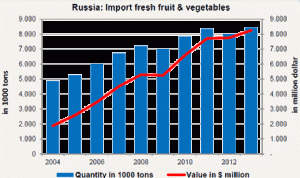In Q1 2020 Russia imported 575,200 MT of vegetables worth $583.5 million. In volume terms, imports increased by 1.1% compared to the same period in 2019, while in monetary terms it was up 8.9%.
During the first quarter of 2020, vegetables were imported to Russia from 96 countries. The main exporting countries were China, Turkey, Israel and Egypt.
Tomatoes make the largest share in Russia’s vegetable imports. During the first 3 months of 2020, thy account for 154,300 MT (+5.8%) worth $200.9 million (+8.9%). The major exporters of tomatoes to Russia were Turkey, Azerbaijan, Morocco, and China.
Imports of peppers increased by 15.5% to 58,800 MT worth $86.7 million, up 22.6%. The largest volumes came from Israel, China, and Turkey. Imports of cabbage amounted to 52,800 MT (-14.7%), worth $29.2 million (-6.7%). Most of these products came in from China and Uzbekistan.
Import of onions and garlic decreased by 11.7% down to 44,600 MT worth $41.3 million, up 19.7%. Onions and garlic were mainly imported from China, the Netherlands, and Egypt.
Egypt was the major exporter of potatoes to Russia in the first quarter of 2020, accounting for more than 90% of deliveries in both volume and monetary terms. During the reporting period, 44,500 MT (+8%) of potatoes worth $17.6 million were imported.
